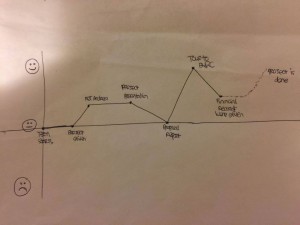This week, we met our weekly objective of analyzing the divided portions of receipts and inputting the information on an Excel sheet. We will be meeting the next week in order to discuss our findings and organize them accordingly as a group. With this information, we hope to sort the purchases based on our determined categories (the food groups as stated by the Canadian Food Guide and for which program the food was primarily purchased for are a couple of examples) and eventually create visuals that would be easier for our community partner to interpret. With these visuals, we will point out positive and/or negative aspects that were discovered from the received financial records.
During the previous week, our group participated in the Moment of Significant Change workshop in order to reflect on the events that have occurred during our project. What we all agreed on as the biggest moment of Significant Change was when we visited the Broadway Youth Resource Center. This gave us a greater understanding of how the BYRC ran and allowed us to see for ourselves who we were working for and how our work can affect them. Another significant event was when we initially met with our community partner Andrea and Jocelyn, who worked together with us to gain direction for our project. Their excitement towards this project and passion towards their cause of helping low-income youth also gave us a sense of enthusiasm towards this project. The lowest point we discussed, was perhaps when we were assigned our proposal report and presentation, since these are not the most appealing of tasks. Although it was tough pinning down exactly what direction we wanted to take and how we were going to achieve our objectives, in the end, writing the proposal really helped give direction to the project and as such was also one of our moments of significance. It was both important and useful for the progress of our project to determine our moments of significance in order to continue in the right path for our project and also to determine what we want the end product to be like.
Our group strategy for successfully completing this project consists of continuing to meet our set deadlines, and successful communication amongst each other, and our community partner. We also hope to create visuals and simplify the information in a way that would be easier to understand, rather than Excel files. Once we have simplified the data, we believe it will be easier to determine recurrent trends and start with the final part of our project which will be assembling all our findings and coming up with a conclusion or final statement on the spending trends. We will keep updating on our progress but for now we will simply say hasta la vista!
